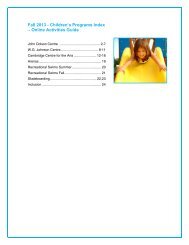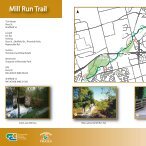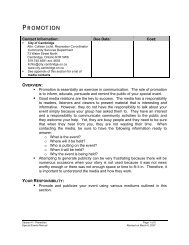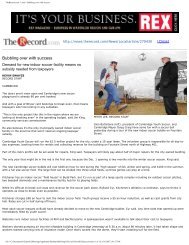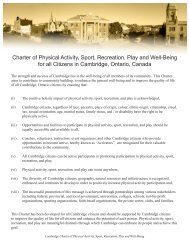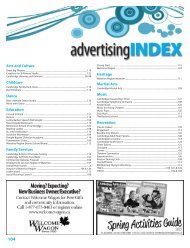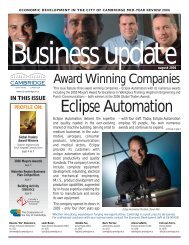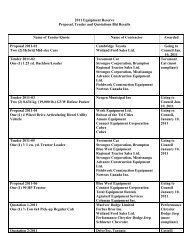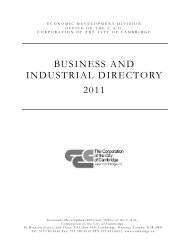City of Cambridge Multi-Purpose Sports and Entertainment ...
City of Cambridge Multi-Purpose Sports and Entertainment ...
City of Cambridge Multi-Purpose Sports and Entertainment ...
Create successful ePaper yourself
Turn your PDF publications into a flip-book with our unique Google optimized e-Paper software.
FINAL REPORT – EXECUTIVE SUMMARY | April 27, 2011<br />
<strong>City</strong> <strong>of</strong> <strong>Cambridge</strong><br />
<strong>Multi</strong>-<strong>Purpose</strong> <strong>Sports</strong> <strong>and</strong><br />
<strong>Entertainment</strong> Feasibility Study
IBI GROUP DRAFT REPORT<br />
EXECUTIVE SUMMARY<br />
April 27, 2011<br />
<strong>City</strong> <strong>of</strong> <strong>Cambridge</strong><br />
FEASIBILITY STUDY FOR A MULTI-PURPOSE SPORTS AND ENTERTAINMENT VENUE<br />
<strong>City</strong> <strong>of</strong> <strong>Cambridge</strong> <strong>Multi</strong>-<strong>Purpose</strong> <strong>Sports</strong> <strong>and</strong> <strong>Entertainment</strong> Feasibility Study<br />
The <strong>City</strong> <strong>of</strong> <strong>Cambridge</strong> recognizes the value <strong>of</strong> recreational services <strong>and</strong> celebrates the personal, social,<br />
economic <strong>and</strong> environmental benefits that they provide. Through the Community Services Department, the<br />
municipality owns <strong>and</strong> operates a dozen recreation facilities, including six (6) arenas that have a total <strong>of</strong> seven<br />
(7) ice pads. The municipality also owns <strong>and</strong> operates a number <strong>of</strong> facilities which accommodate a range <strong>of</strong> arts<br />
<strong>and</strong> cultural activities <strong>and</strong> events. Residents <strong>and</strong> visitors to <strong>Cambridge</strong> also have access to sports <strong>and</strong><br />
entertainment facilities that are owned <strong>and</strong> operated by the private sector (e.g. the <strong>Cambridge</strong> Ice Park <strong>and</strong> the<br />
<strong>Cambridge</strong> Ice Centre) <strong>and</strong> various community organizations (e.g. the YMCA).<br />
Most <strong>of</strong> the municipality’s arenas are several decades old. The <strong>City</strong> does not have a multi-use recreation<br />
complex that includes ice pads, aquatic facilities, <strong>and</strong> other amenities. It also does not have a multi-purpose<br />
sports <strong>and</strong> entertainment centre that could house a major sports franchise (e.g. Ontario Hockey League (OHL),<br />
the American Hockey League (OHL) or the National Lacrosse League (NLL)) or that can hold large<br />
entertainment events. The new 15,000 sq. ft. performing arts complex being built in downtown <strong>Cambridge</strong> will<br />
have between 500 <strong>and</strong> 600 seats, <strong>and</strong> as such will have the capacity to accommodate small to mid-sized<br />
events.<br />
PURPOSE OF THE MULTI-PURPOSE SPORTS AND ENTERTAINMENT FEASIBILITY STUDY<br />
IBI Group was retained by the <strong>City</strong> <strong>of</strong> <strong>Cambridge</strong> to conduct a basic feasibility analysis in order to confirm if there<br />
is a business case to develop a major sports <strong>and</strong> entertainment centre in the <strong>City</strong> <strong>of</strong> <strong>Cambridge</strong> or if a smaller<br />
multi-use recreation complex would be more feasible/appropriate. IBI Group undertook the following tasks to<br />
gauge the current <strong>and</strong> potential future market dem<strong>and</strong> for a new 6,000 seat centre:<br />
� Identified opportunities to attract a primary tenant (i.e. a pr<strong>of</strong>essional sports team/franchise);<br />
� Reviewed the existing supply <strong>of</strong> sports <strong>and</strong> entertainment centres within proximity to the <strong>City</strong> <strong>of</strong><br />
<strong>Cambridge</strong> (i.e. competition), as well as the recent usage/performance <strong>of</strong> these facilities; <strong>and</strong><br />
� Investigated opportunities to attract major entertainment events (e.g. as concerts <strong>and</strong> trade shows)<br />
as well as patrons (i.e. residents <strong>of</strong> <strong>Cambridge</strong>, residents <strong>of</strong> the larger region <strong>and</strong> tourists/visitors).<br />
EXISTING SERVICE STANDARDS FOR ICE PADS<br />
Through a partnership agreement, the <strong>City</strong> has access to 28 hours <strong>of</strong> ice time per week at the <strong>Cambridge</strong> Ice<br />
Park. This access is considered to be equal to 0.5 municipal ice pads. The <strong>City</strong> <strong>of</strong> <strong>Cambridge</strong> Master Plan for<br />
Parks, Recreation <strong>and</strong> Open Space (2002 to 2022) includes a guideline <strong>of</strong> providing one municipal (1) ice pad<br />
per 15,000 people. The Plan suggests that this guideline can be reduced where there are ice facilities<br />
provided by the private sector or other public agencies. With an estimated population <strong>of</strong> 130,000 in 2010,<br />
<strong>Cambridge</strong> residents currently enjoy the following service st<strong>and</strong>ards for ice, which are higher than the service<br />
st<strong>and</strong>ards found in many other municipalities:<br />
� Municipal Ice Pads (i.e. 7.5 pads): One (1) ice pad per 17,333; <strong>and</strong><br />
� Municipal <strong>and</strong> Non-Municipal Ice Pads (i.e. 10 ice pads): One (1) ice pad per 13,000 people.<br />
During the 2009/2010 season, some 3,697 people were registered with minor or recreational teams that use the<br />
<strong>City</strong>’s ice facilities. This translates into a ratio <strong>of</strong> approximately 493 participants per ice pad. A number <strong>of</strong><br />
Ontario municipalities suggest a service target <strong>of</strong> one (1) ice pad per 700 registered participants within their<br />
recreation master plans (e.g. The Town <strong>of</strong> Oakville, the <strong>City</strong> <strong>of</strong> Kingston, the Township <strong>of</strong> Centre Wellington <strong>and</strong><br />
the Town <strong>of</strong> Caledon).<br />
There may be high dem<strong>and</strong> for prime time ice at the <strong>City</strong>’s arenas. However, unlike in many other municipalities,<br />
shoulder times such as early weekday <strong>and</strong> weekend mornings <strong>and</strong> late evenings are not fully booked. Only 62%<br />
<strong>of</strong> the <strong>City</strong>’s ice allocation at the <strong>Cambridge</strong> Ice Park was booked in 2009/2010.
ANTICIPATED FUTURE ICE PAD REQUIREMENTS<br />
<strong>City</strong> <strong>of</strong> <strong>Cambridge</strong> <strong>Multi</strong>-<strong>Purpose</strong> <strong>Sports</strong> <strong>and</strong> <strong>Entertainment</strong> Feasibility Study<br />
Continued growth <strong>of</strong> the 0 to 19 age category in <strong>Cambridge</strong> is expected over the next several decades. It is<br />
difficult to predict how population growth will impact participation in ice activities, as in the past five years<br />
registration in girls <strong>and</strong> boys hockey, figure skating <strong>and</strong> ringette in the <strong>City</strong> <strong>of</strong> <strong>Cambridge</strong> has not increased.<br />
With the <strong>City</strong>’s population anticipated to grow by 63,000 people between 2010 <strong>and</strong> 2036, three (3) to five<br />
(5) additional ice pads could be required to serve the local community.<br />
Service st<strong>and</strong>ards, however, do not take into consideration the age, size, quality <strong>and</strong> location <strong>of</strong> facilities. As<br />
noted, the majority <strong>of</strong> the <strong>City</strong>’s arenas are several decades old <strong>and</strong> only the Galt Garden Arena can<br />
accommodate more than 1,100 spectators.<br />
MARKET DEMAND<br />
There are currently a number <strong>of</strong> multi-purpose sports <strong>and</strong> entertainment centres located within 100 km <strong>of</strong> the<br />
<strong>City</strong> <strong>of</strong> <strong>Cambridge</strong>, including:<br />
� The Aud, Kitchener: Fixed seating for 7,100 spectators. Home to the Kitchener Rangers<br />
(OHL);<br />
� The John Labatt Centre, London: Fixed seating for 9,090 spectators. Home to the London<br />
Knights (OHL);<br />
� The Sleeman Centre, Guelph: Fixed seating for 4,500 spectators. Home to the Guelph Storm<br />
(OHL) <strong>and</strong> the Guelph Hurricanes (Junior B);<br />
� Copps Coliseum, Hamilton: Fixed seating for 17,383 spectators. Home to the Hamilton<br />
Bulldogs (AHL); <strong>and</strong><br />
� The Powerade Centre, Brampton: Fixed seating for 4,980. Home to the Brampton Battalion<br />
(OHL), Brampton Thunder (North West Hockey League) <strong>and</strong> the Brampton Excelsiors (Ontario<br />
Lacrosse League).<br />
Various industry <strong>and</strong> facility reports show that due to poor global economic conditions, changes in consumer<br />
preferences, the growing choice <strong>of</strong> recreation <strong>and</strong> entertainment activities <strong>and</strong> lower volumes <strong>of</strong> tourism, there<br />
has been a decline in attendance <strong>and</strong> spending at sports <strong>and</strong> entertainment facilities in Ontario.<br />
There appears to be minimal market dem<strong>and</strong> for a 6,000 seat centre in the <strong>City</strong> <strong>of</strong> <strong>Cambridge</strong> to host<br />
sports <strong>and</strong> entertainment events.<br />
Due to the locational/territorial requirements <strong>of</strong> major sports franchises (i.e. a minimum separation distance <strong>of</strong> 80<br />
km to 120 km), it is unlikely that a new OHL, AHL or NLL team could be established in the <strong>City</strong> <strong>of</strong> <strong>Cambridge</strong>.<br />
In the absence <strong>of</strong> a key tenant, there is no financially sustainable business case for the development <strong>of</strong> a<br />
new multi-purpose sports <strong>and</strong> entertainment centre in <strong>Cambridge</strong>.<br />
ESTIMATED CAPITAL AND OPERATING COSTS FOR A 6,000 SEAT MULTI-USE SPORTS AND<br />
ENTERTAINMENT CENTRE<br />
Over the past decade, a number <strong>of</strong> centres have been built in Canada including several within approximately<br />
100 km or an hour drive <strong>of</strong> <strong>Cambridge</strong> (e.g. the Sleeman Centre located in Guelph, the John Labatt Centre in<br />
London <strong>and</strong> the Powerade Centre in Brampton). Capital costs for centres built within the past five years range<br />
from an estimated $8,182 per seat to $13,622 per seat. The majority <strong>of</strong> multi-purpose sports <strong>and</strong> entertainment<br />
centres are municipally owned <strong>and</strong> most municipalities received provincial <strong>and</strong>/or federal capital funding <strong>and</strong>/or<br />
private contributions (e.g. donations <strong>and</strong> naming rights) to assist with the construction costs.<br />
April 27, 2011 Page 2
<strong>City</strong> <strong>of</strong> <strong>Cambridge</strong> <strong>Multi</strong>-<strong>Purpose</strong> <strong>Sports</strong> <strong>and</strong> <strong>Entertainment</strong> Feasibility Study<br />
IBI Group estimates that it will cost approximately $56.0 million (2010 dollars, excluding l<strong>and</strong>) to<br />
construct a new 6,000 seat multi-purpose sports <strong>and</strong> entertainment centre (i.e. approximately $8,200 per<br />
seat plus additional costs associated with the second ice pad).<br />
For the purpose <strong>of</strong> generating estimates <strong>of</strong> annual operating costs, annual revenues <strong>and</strong> return on investment,<br />
IBI Group assumed that if a new 6,000 centre was built in <strong>Cambridge</strong> it would have a main tenant.<br />
Even with main tenants, many municipalities have struggled to generate enough revenue from ticket sales,<br />
facility rentals, advertising, concessions, etc., to cover annual operating costs as well as capital reserves <strong>and</strong><br />
debt financing. Some have experienced significant problems with defaults on loans/partnership agreements<br />
<strong>and</strong> payments for naming rights, the loss <strong>of</strong> key tenants <strong>and</strong> competition with other venues/municipalities to<br />
attract major events. As such, the assumptions used by IBI Group to generate estimates <strong>of</strong> annual revenues<br />
(e.g. number <strong>of</strong> annual entertainment events, attendance at sports <strong>and</strong> non-sporting events, rental hours for<br />
prime <strong>and</strong> non-prime time ice, concessions revenue, etc.) are somewhat conservative, but reflect the recent<br />
experiences <strong>of</strong> facilities in Ontario (e.g. the K-Rock Centre in Kingston, the GM Centre in Oshawa, the Essar<br />
Centre in Sault Ste. Marie <strong>and</strong> the Sleeman Centre in Guelph) as well as the challenges <strong>Cambridge</strong> might face<br />
in attracting events <strong>and</strong> patrons due to the number <strong>of</strong> competing sports <strong>and</strong> entertainment venues.<br />
IBI Group estimated that in year one the 6,000 seat multi-purpose sports <strong>and</strong> entertainment centre could<br />
generate $2.4 million in revenues, but that operating costs (including capital reserve payments) could<br />
total $2.6 million. This operating deficit does not include debt repayment.<br />
As noted, the estimated construction cost <strong>of</strong> the 6,000 seat multi-purpose sports <strong>and</strong> entertainment centre is $56<br />
million to construct. Even with the $12.5 million identified within the <strong>City</strong> <strong>of</strong> <strong>Cambridge</strong>’s 2010 Ten Year Capital<br />
Budget forecasts for the replacement <strong>of</strong> two <strong>of</strong> the municipality’s aging arenas in 2019, the possibility <strong>of</strong> using<br />
development charge revenue <strong>and</strong> potential grants <strong>and</strong> partnerships, it is likely that the <strong>City</strong> would need to borrow<br />
some money to finance the development. Using the above-noted estimates <strong>of</strong> annual operating costs <strong>and</strong><br />
revenues, IBI Group ran a 25-year pr<strong>of</strong>orma for a 6,000 seat centre under three hypothetical funding scenarios.<br />
The scenarios assumed varying proportions <strong>of</strong> the total capital costs would be covered by the <strong>City</strong> <strong>of</strong> <strong>Cambridge</strong><br />
<strong>and</strong> variations in the amount <strong>of</strong> money that the <strong>City</strong> would need to borrow (i.e. debt finance):<br />
� Scenario A: 100% <strong>of</strong> the capital costs to be paid for by the <strong>City</strong>, with 70% (i.e. $39.5 million)<br />
to be financed;<br />
� Scenario B: 89% <strong>of</strong> the capital costs to be paid for by the <strong>City</strong>, with 60% (i.e. $33.5 million) to<br />
be financed; <strong>and</strong><br />
� Scenario C: 50% <strong>of</strong> the capital costs to be paid for by the <strong>City</strong>, with 21% (i.e. $11.5 million) to<br />
be financed.<br />
As shown in Figure A below, IBI Group estimates that over a 25-year operating period a new 6,000 seat<br />
multi-purpose sports <strong>and</strong> entertainment centre, with a main tenant, could incur a deficit <strong>of</strong> between $19<br />
million (net present value, Scenario C) <strong>and</strong> $47.5 million (net present value, Scenario A).<br />
Should the <strong>City</strong> <strong>of</strong> <strong>Cambridge</strong> raise all $56 million dollars <strong>and</strong> avoid the need for debt financing, IBI Group<br />
estimates that the new multi-purpose sports <strong>and</strong> entertainment centre may generate a loss <strong>of</strong> only $7.3 million<br />
(net present value) over a 25-year operating period.<br />
April 27, 2011 Page 3
<strong>City</strong> <strong>of</strong> <strong>Cambridge</strong> <strong>Multi</strong>-<strong>Purpose</strong> <strong>Sports</strong> <strong>and</strong> <strong>Entertainment</strong> Feasibility Study<br />
Figure A. Financial Feasibility Analysis - 6,000 Seat <strong>Multi</strong>-<strong>Purpose</strong> <strong>Sports</strong> <strong>and</strong> <strong>Entertainment</strong> Centre<br />
A.<br />
B.<br />
C.<br />
Funding<br />
Scenarios<br />
Funded by the<br />
<strong>City</strong> (100%)<br />
Funded by the<br />
<strong>City</strong> (89%) <strong>and</strong><br />
Grants (11%)<br />
Funded by the<br />
<strong>City</strong> (50%) <strong>and</strong><br />
Private Partner<br />
(50%)<br />
Potential Sources <strong>of</strong> Development<br />
Funding (i.e. $56.04 Million)<br />
Estimates for Year 1 <strong>of</strong> Operations<br />
Excluding Debt Financing<br />
Revenues<br />
Operating<br />
Costs<br />
Pr<strong>of</strong>it/Deficit<br />
Year 1 <strong>of</strong><br />
Operations<br />
Pr<strong>of</strong>it/Deficit<br />
Municipal Reserves $12,500,000<br />
Development Charges $4,000,000<br />
Grants $0 $2,439,663 -$2,587,742 -$148,079 -$3,415,685<br />
Partner Funding $0<br />
Financing $39,540,000<br />
Municipal Reserves $12,500,000<br />
Development Charges $4,000,000<br />
Grants $6,000,000 $2,439,663 -$2,587,742 -$148,079 -$2,945,842<br />
Partner Funding $0<br />
Financing $33,540,000<br />
Municipal Reserves $12,500,000<br />
Development Charges $4,000,000<br />
Grants $0 $2,439,663 -$2,587,742 -$148,079 -$1,100,098<br />
Partner Funding $28,020,000<br />
Financing $11,520,000<br />
Estimates Including Debt<br />
Financing<br />
Key Assumptions:<br />
- Capital cost for 6,000 seat rink assumed at $8,200 per seat (w hich includes s<strong>of</strong>t costs)<br />
- Capital cost for second ice pad assumed to be $190 per sq. ft. (plus 20% for s<strong>of</strong>t costs)<br />
- Total capital costs, excluding debt financing, estimated to be $56,040,000<br />
- Operating cost estimates include capital reserve contributions<br />
- Interest rate <strong>of</strong> 5.5% p.a. used, along w ith annual escalation rate <strong>of</strong> 3%<br />
- Financing assumed to be over a 25-year period (2 years for construction <strong>and</strong> 23 years <strong>of</strong> operation)<br />
- Estimates <strong>of</strong> costs <strong>and</strong> revenues for Year 1 <strong>of</strong> Operations based on 2010 estimates <strong>and</strong> a 3% annual escalation<br />
- Both ice pads w ill operate year round<br />
- Only the portion <strong>of</strong> the facility that is required to address grow th-related needs in the <strong>City</strong> w ould be eligible for development charge funding<br />
25-Year Facility<br />
Return on<br />
Investment<br />
(NPV)<br />
-$47,465,101<br />
-$41,684,449<br />
-$18,975,554<br />
It should be stressed that the pr<strong>of</strong>ormas prepared by IBI Group are based on high level order <strong>of</strong> magnitude cost<br />
estimates <strong>and</strong> various funding <strong>and</strong> revenue assumptions. A complete business case <strong>and</strong> detailed costing<br />
analysis will need to be undertaken by the <strong>City</strong> <strong>of</strong> <strong>Cambridge</strong> <strong>and</strong>/or a second party prior to selecting a preferred<br />
development option (i.e. major sports <strong>and</strong> entertainment centre or a community-based multi-use recreation<br />
complex) <strong>and</strong> pursuing a tenant agreement.<br />
Ultimately, whether or not the <strong>City</strong> <strong>of</strong> <strong>Cambridge</strong> is able to pursue the development <strong>of</strong> a new centre is dependent<br />
on the availability <strong>of</strong> funding <strong>and</strong> whether or not:<br />
� The municipality is willing to tolerate a large annual deficit <strong>and</strong> subsidize recreation <strong>and</strong><br />
entertainment in the hope that the construction <strong>and</strong> operation <strong>of</strong> a new centre will result in<br />
significant positive economic impacts to the <strong>City</strong> (e.g. increased resident <strong>and</strong> tourist<br />
spending, new jobs, increased taxes, etc.); <strong>and</strong><br />
� Economic <strong>and</strong> market conditions change <strong>and</strong> revenues are significantly higher than what has<br />
been estimated in this analysis (e.g. more events, higher spending on concessions, <strong>and</strong><br />
greater dem<strong>and</strong> for advertising space).<br />
In summary, even with a key tenant, unless the dem<strong>and</strong> for sports <strong>and</strong> entertainment increases, along<br />
with spectator spending, there is not a business case for the development <strong>of</strong> a new multi-purpose sports<br />
<strong>and</strong> entertainment centre in <strong>Cambridge</strong>.<br />
April 27, 2011 Page 4
<strong>City</strong> <strong>of</strong> <strong>Cambridge</strong> <strong>Multi</strong>-<strong>Purpose</strong> <strong>Sports</strong> <strong>and</strong> <strong>Entertainment</strong> Feasibility Study<br />
ESTIMATED CAPITAL AND OPERATING COSTS - 2,000 SEAT MULTI-USE RECREATION COMPLEX<br />
An alternative to developing a 6,000 seat centre is for the <strong>City</strong> <strong>of</strong> <strong>Cambridge</strong> to develop a smaller multi-use<br />
recreation complex that would primarily accommodate the needs <strong>of</strong> local residents <strong>and</strong> groups, but that could<br />
also be used for some smaller spectator <strong>and</strong> entertainment events. IBI Group generated capital <strong>and</strong> operating<br />
cost estimates for two community complex options: 1) a 2,000 seat facility or 2) a 750 seat facility.<br />
As per the study terms <strong>of</strong> reference, the option for both complexes to include a twin pad arena, a gymnasium,<br />
meeting spaces <strong>and</strong> indoor swimming pool was explored. Capital costs for 100,000 plus sq. ft. multi-use<br />
recreation complexes built in Ontario over the past five years have ranged from an estimated $160 to over $200<br />
per sq. ft. Many municipalities have received capital funding assistance (e.g. Build Canada fund) <strong>and</strong> some<br />
have sold naming rights or undertaken community fundraising to cover a portion <strong>of</strong> the construction costs.<br />
IBI Group estimates it will cost approximately $29.3 million (2010 dollars, excluding l<strong>and</strong>) to build a new<br />
2,000 seat multi-use recreation complex <strong>and</strong> $24.6 million (2010 dollars, excluding l<strong>and</strong>) to build a new<br />
750 seat complex.<br />
Some municipalities have reported considerable cost savings <strong>and</strong> operational efficiencies with the consolidation<br />
<strong>of</strong> activities <strong>and</strong> amenities into one complex. However, given the high operating costs associated with ice <strong>and</strong><br />
indoor swimming pools, community programming <strong>and</strong> the need for capital reserve contributions, user fee<br />
revenues rarely cover the total cost <strong>of</strong> operations. A net operating cost to the municipality (i.e. deficit) is<br />
common <strong>and</strong> normally tolerated for such public recreation facilities <strong>and</strong> services.<br />
IBI Group ran financial pr<strong>of</strong>ormas for the large <strong>and</strong> small complex options under two hypothetical funding<br />
scenarios, which assumed varying amounts <strong>of</strong> debt financing to be carried by the <strong>City</strong>:<br />
� 2,000 seat complex: 100% funded by the <strong>City</strong> (Scenario A) or 75% financed by the <strong>City</strong><br />
(Scenario B); <strong>and</strong><br />
� 750 seat complex: 100% funded by the <strong>City</strong> (Scenario A) or 70% financed by the <strong>City</strong><br />
(Scenario B).<br />
Very few community arenas have more than 1,000 fixed seats. Junior A <strong>and</strong> B <strong>and</strong> Senior A hockey games<br />
generally do not require seating for more than 500 spectators <strong>and</strong> there are limited opportunities to attract small<br />
to mid-sized entertainment events (e.g. concerts, conventions, trade shows) at multi-use recreation complexes.<br />
IBI Group estimates that the net cost over a 25-year operating period for a new 2,000 seat complex would<br />
be between $19.6 <strong>and</strong> $27 million, assuming debt financing is required.<br />
As shown in Figure B below, IBI Group estimates that with debt financing, over a 25-year operating<br />
period a new 750 seat multi-use recreation complex could incur a net cost <strong>of</strong> between $15.7 (net present<br />
value, Scenario B) <strong>and</strong> $21.9 million (net present value, Scenario A).<br />
The <strong>City</strong> <strong>of</strong> <strong>Cambridge</strong> does not have a history <strong>of</strong> incurring debt. Should the <strong>City</strong> <strong>of</strong> <strong>Cambridge</strong> raise all<br />
$24.6 million dollars to cover capital costs <strong>and</strong> avoid the need for debt financing, then over a 25-year<br />
operating period IBI Group estimates that the new 750 seat multi-use recreation complex would cost only<br />
$13.7 million (net present value, Scenario B).<br />
April 27, 2011 Page 5
<strong>City</strong> <strong>of</strong> <strong>Cambridge</strong> <strong>Multi</strong>-<strong>Purpose</strong> <strong>Sports</strong> <strong>and</strong> <strong>Entertainment</strong> Feasibility Study<br />
Figure B. Financial Feasibility Analysis - 750 Seat <strong>Multi</strong>-Use Recreation Complex<br />
A.<br />
B.<br />
Funding<br />
Scenarios<br />
Funded<br />
Entirely by<br />
the <strong>City</strong> <strong>of</strong><br />
<strong>Cambridge</strong><br />
Funded by<br />
the <strong>City</strong><br />
(70%) <strong>and</strong><br />
Partner<br />
(30%)<br />
CONCLUSIONS<br />
Potential Sources <strong>of</strong><br />
Development Funding (i.e. $24.57<br />
Million)<br />
Estimates for Year 1 <strong>of</strong> Operations<br />
Excluding Debt Financing<br />
Revenues<br />
Operating<br />
Costs<br />
Pr<strong>of</strong>it/Deficit<br />
Municipal Reserves $12,500,000<br />
Development Charges $4,000,000<br />
Grants $0 $1,502,873 -$2,205,440 -$702,567<br />
Partner Funding $0<br />
Financing (debt service) $8,070,000<br />
Municipal Reserves $12,500,000<br />
Development Charges $4,000,000<br />
Grants $0 $1,502,873 -$2,205,440 -$702,567<br />
Partner Funding $7,312,500<br />
Financing (debt service) $757,500<br />
Estimates Including Debt<br />
Financing<br />
Year 1 <strong>of</strong><br />
Operations<br />
Pr<strong>of</strong>it/Deficit<br />
-$1,369,476<br />
25-Year Facility<br />
Return on<br />
Investment (NPV)<br />
-$21,944,702<br />
-$861,857 -$15,699,269<br />
Key Assumptions:<br />
- 105,000 sq. ft. facility w ith a tw in pad arena (Main Pad: 750 seats, Second Pad: 250 seats), indoor sw imming pool <strong>and</strong> community rooms<br />
- Capital cost <strong>of</strong> $195 per sq. ft. (plus 20% for s<strong>of</strong>t costs)<br />
- Total capital costs excluding debt financing, estimated to be $24,570,000<br />
- Operating cost estimates include capital reserve contributions<br />
- Revenues <strong>and</strong> expenses are based on <strong>City</strong> <strong>of</strong> <strong>Cambridge</strong> 2010 Operating Budget <strong>and</strong> municipal case study research<br />
- Interest rate used is 5.5% p.a. <strong>and</strong> annual escalation used is 3%<br />
- Financing assumed to be over a 25-year period (2 years for construction <strong>and</strong> 23 years <strong>of</strong> operation)<br />
- Estimates <strong>of</strong> costs <strong>and</strong> revenues for Year 1 <strong>of</strong> Operations based on 2010 estimates <strong>and</strong> a 3% annual escalation<br />
- Only the portion <strong>of</strong> the facility that is required to address grow th-related needs in the <strong>City</strong> w ould be eligible for development charge funding<br />
Given the outcome <strong>of</strong> the financial analysis <strong>and</strong> the m<strong>and</strong>ate <strong>of</strong> the <strong>City</strong> <strong>of</strong> <strong>Cambridge</strong> Master Plan for<br />
Parks, Recreation <strong>and</strong> Open Space, there is a stronger business case for the development <strong>of</strong> multi-use<br />
recreation complex in the <strong>City</strong> <strong>of</strong> <strong>Cambridge</strong>, particularly a 750 seat option, in that:<br />
� The complex would primarily accommodate the needs <strong>of</strong> minor <strong>and</strong> recreational user groups<br />
<strong>and</strong> local residents;<br />
� There is a higher tolerance for municipal funding (<strong>and</strong> annual net costs/deficits) for<br />
community-based recreation facilities <strong>and</strong> services, as opposed to entertainment which<br />
normally is provided by the private sector <strong>and</strong> paid entirely by users;<br />
� A 750 seat complex would cost the municipality significantly less in terms <strong>of</strong> capital costs <strong>and</strong><br />
debt financing;<br />
� The decommissioning <strong>of</strong> older facilities <strong>and</strong> the consolidation <strong>of</strong> facilities/activities into one<br />
complex will likely result in operational savings; <strong>and</strong><br />
� A new complex could also be used to host some smaller spectator <strong>and</strong> entertainment events,<br />
conventions <strong>and</strong> meetings. These activities could generate some economic benefits to the<br />
community.<br />
A new complex, with a twin pad arena <strong>and</strong> aquatic facilities, may not be required for several years<br />
given the current high st<strong>and</strong>ard for ice <strong>and</strong> the life expectancy <strong>of</strong> the <strong>City</strong>’s existing facilities.<br />
April 27, 2011 Page 6
NEXT STEPS<br />
<strong>City</strong> <strong>of</strong> <strong>Cambridge</strong> <strong>Multi</strong>-<strong>Purpose</strong> <strong>Sports</strong> <strong>and</strong> <strong>Entertainment</strong> Feasibility Study<br />
The feasibility study found that currently there is not a business case for a 6,000 seat multi-purpose sports <strong>and</strong><br />
entertainment centre in the <strong>City</strong> <strong>of</strong> <strong>Cambridge</strong>. It is unlikely there will be a business case for a new centre in the<br />
short to medium-term (e.g. next five to ten years). However, the <strong>Cambridge</strong> Community Services Master Plan<br />
Update Committee should continue to investigate opportunities to attract <strong>and</strong> accommodate a major sports<br />
franchise, including an investor, as well as funding opportunities to share the capital construction costs. The<br />
municipality should also continue to monitor:<br />
� The financial performance <strong>of</strong> other sports <strong>and</strong> entertainment centres <strong>and</strong> the impact they are<br />
having on the local economy;<br />
� Community ice/arena requirements <strong>and</strong> the need for new ice pads; <strong>and</strong><br />
� Tax payer support for the development <strong>of</strong> either a new multi-purpose sport <strong>and</strong> entertainment<br />
centre or a smaller community complex.<br />
Without a business case for a new 6,000 seat multi-purpose sports <strong>and</strong> entertainment centre or the current need<br />
for a multi-use recreation complex, it is premature to undertake a detailed site investigation. However, the <strong>City</strong><br />
can begin to identify potential sites to accommodate a new facility, including properties currently owned by the<br />
municipality as well as l<strong>and</strong>s owned by the private sector <strong>and</strong> other public agencies, <strong>and</strong> weigh the pros <strong>and</strong><br />
cons <strong>of</strong> both downtown locations <strong>and</strong> greenfield locations.<br />
It is important to note that the findings <strong>of</strong> this feasibility analysis are not intended to suggest that the <strong>City</strong> <strong>of</strong><br />
<strong>Cambridge</strong> should not continue to plan for the refurbishment or replacement <strong>of</strong> its aging ice facilities in order to<br />
meet user expectations. The <strong>City</strong> <strong>of</strong> <strong>Cambridge</strong> is committed to continuing to explore the best approach to<br />
accommodating the ice requirements <strong>of</strong> its citizens (e.g. new multi-pad arena(s) or a multi-use facility).<br />
April 27, 2011 Page 7




